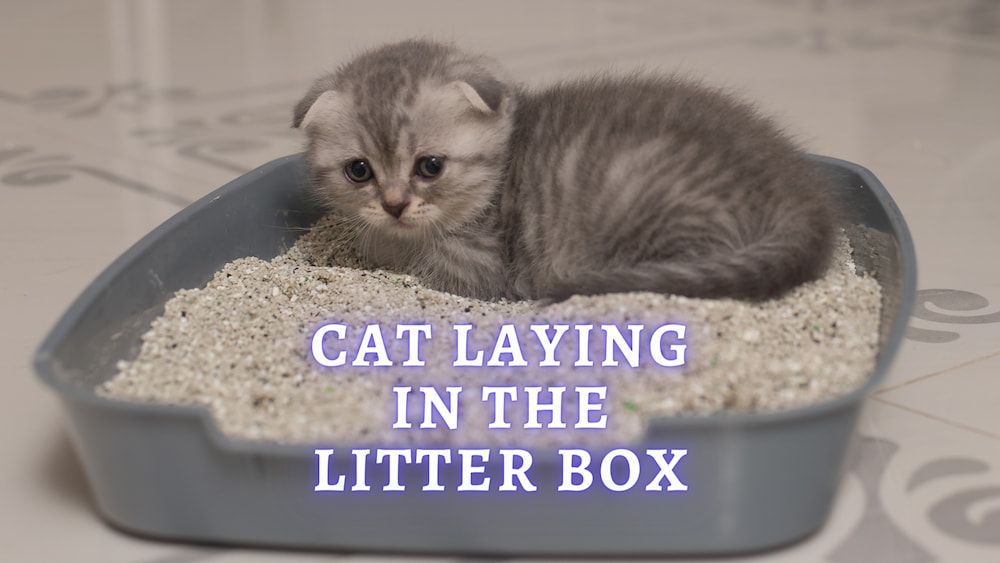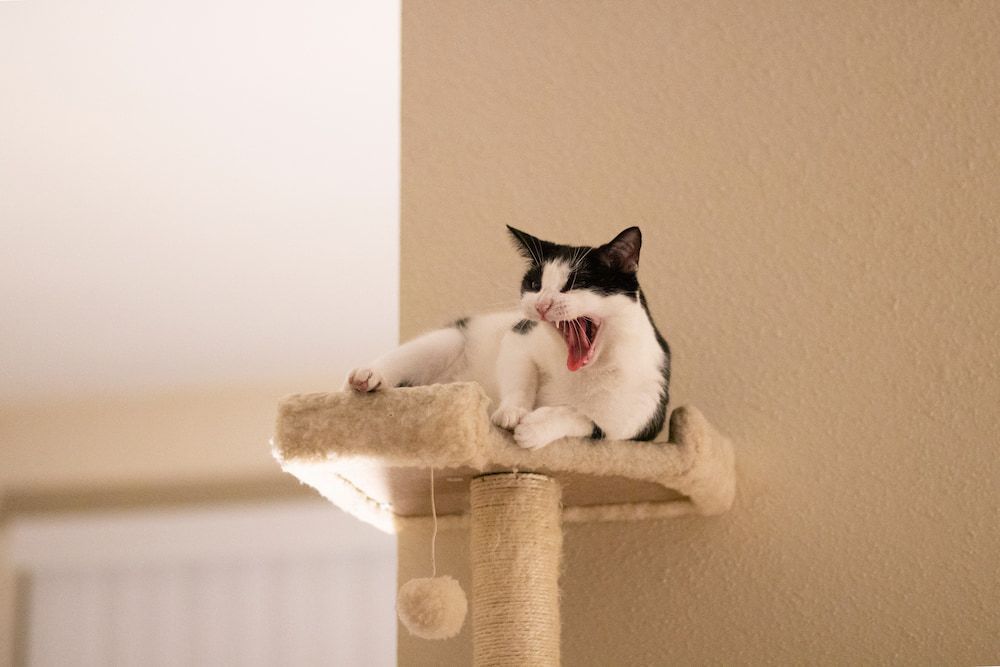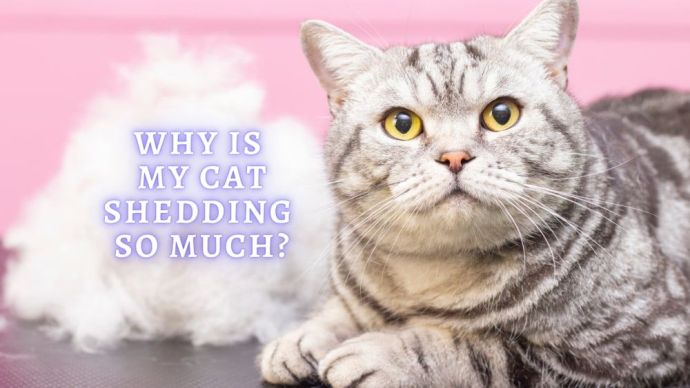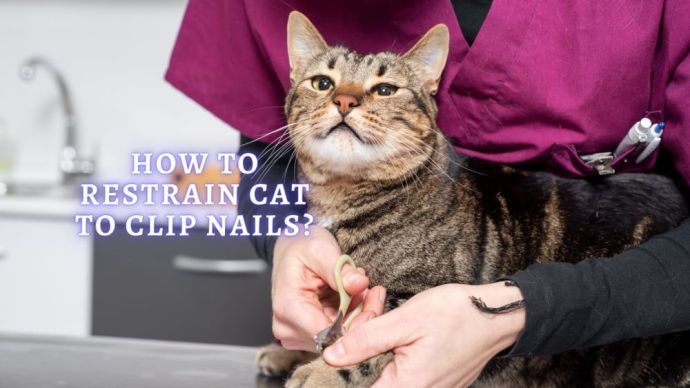Why Is My Cat Laying in the Litter Box? Tips and Solutions
Written by:
Author: Carol Young
Carol has worked in specialty, emergency, mixed animal and general veterinary practices, and enjoys all aspects of veterinary medicine. Her special areas of interest include anesthesia, critical care, emergency, dentistry, internal medicine and small animal nutrition.
View all 62 articlesLearn about our editorial process and veterinary review board.
Viewed: 68
Updated on: 06/15/2023
Unlike dogs, who seem to relish getting dirty, cats are well-known for being clean and tidy, especially when it comes to grooming and self-care. However, if you are a cat owner, and notice that your cat has started laying in her litterbox, you may rightfully be a little concerned.
In some cases, this behavior shouldn’t be a big concern, especially if your cat only lounges in the litterbox occasionally and is showing no other signs of ill health or behavior. But, it can be a sign of something else that may involve a trip to your veterinarian.
There are several reasons why cats like to lay in their litter boxes, and there are also some ways to help your kitty choose a cleaner and more comfortable napping area.
Why is my cat laying in his or her litterbox?
If you notice that your cat is suddenly laying in the litter box or seems to be hiding in it, it could be due to a number of reasons, either medical or behavioral.
Here are some reasons why your feline pal may be spending a lot of time in her litter pan.
1. Urinary Tract Infection
As with other animals, cats sometimes get urinary tract infections (UTIs), which occurs when there is an overgrowth of bacteria in the bladder, which can cause inflammation, pain, and blood in the urine. If your kitty is spending a lot of time in the litterbox, dribbling urine, or going frequently but producing only a little bit of urine, make an appointment with your vet.
Also, if you notice blood in the urine, call your veterinarian immediately. Untreated UTIs can cause extreme discomfort and potentially damage the kidneys. Diagnosis typically involves your vet doing a urinalysis and prescribing antibiotics if bacteria are seen on examination.
2. “Blocked Tom”
This condition occurs most often in overweight neutered males (but can occur in females), and is an immediate medical emergency. A “Blocked Tom” refers to an obstruction of the urethra that leads from the bladder to the penis, and this blockage can be caused by urine crystals or something else that prevents the bladder from emptying.
Symptoms include a distended bladder and repeated visits to or laying in the litterbox without producing any urine.
The reason that this condition is a veterinary emergency is that when a cat cannot urinate, the bladder becomes distended and painful, and toxins build up in the bloodstream that can harm all body systems, including the kidneys.
If you think that your cat is blocked, call your veterinarian immediately.
3. Your Cat is Painful
Sometimes our pets prefer hiding in unusual places when they’re painful or not feeling well. In these cases, cats prefer to keep to themselves and hide, even if it’s in a litter box full of cat litter. Older cats that have joint or mobility issues may prefer laying in the litter pan and may be reluctant to move to a more comfy spot.
If you think that your cat may be painful or not feeling quite right, schedule an appointment with your veterinarian. Your vet may be able to diagnose the cause and offer a treatment plan.
4. Diarrhea/Constipation
Sometimes cats with GI problems, such as diarrhea or the reverse, constipation, may spend more time in the litter tray than usual. If you have changed your cat’s diet or if your cat suffers from IBD (irritable bowel syndrome), it may be a valid reason for loose stools and diarrhea. Also, if your cat has not defecated in 2-3 days but is eating and drinking fine, she may be constipated or obstipated.
Obstipation in cats occurs most often in overweight felines who lack enough fiber and/or water in their diet and is characterized by an inability to pass stool. It can be caused by a medical condition called “megacolon,” in which the colon lacks the necessary function to move stool through the colon to the rectum.
If you suspect that your cat has diarrhea or constipation, contact your veterinarian and schedule an exam to rule out any medical conditions.
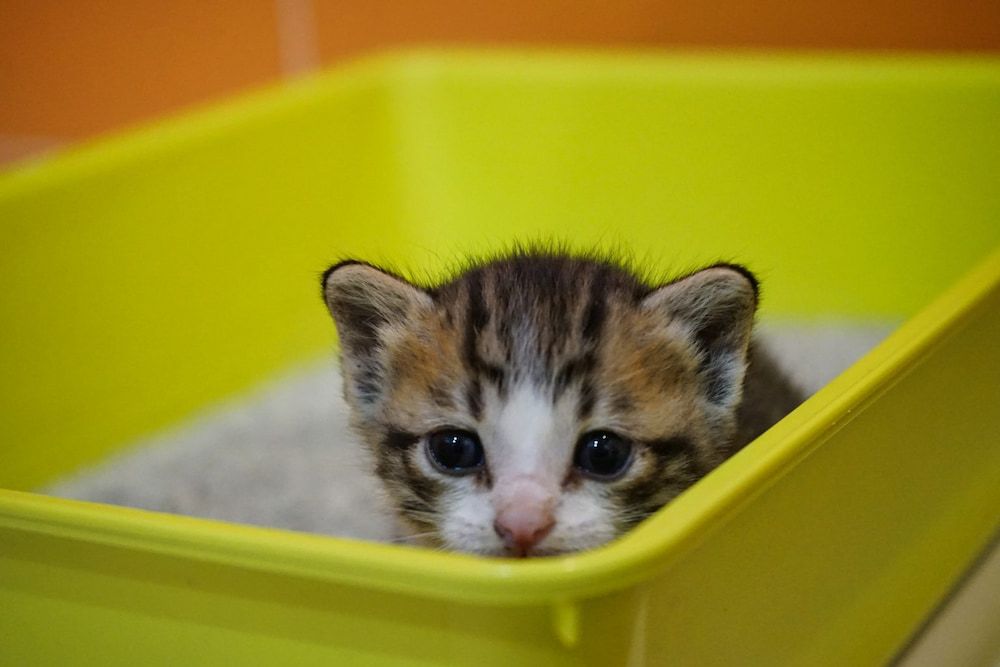 CCO licensed photo by Nilo Velez from the WordPress Photo Directory: https://wordpress.org/photos/photo/21761b9297/
CCO licensed photo by Nilo Velez from the WordPress Photo Directory: https://wordpress.org/photos/photo/21761b9297/5. Stress
Most owners put their litter pans in a quiet, enclosed space out of the way of traffic. This way, a cat can do her business in a secure place with familiar smells because cats love familiarity. Because cats are true creatures of habit and typically don’t like disruptions to their daily routines, your cat may seek solace in her litter box if there are changes in her environment, such as the introduction of a new pet or family member.
The litter box is a safe and familiar haven, and if a cat is stressed, she will avoid interactions with humans or other pets and may even sleep in her litter box. A cat’s environment should be as stress-free as possible.
If you think that your pet is stressed, contact your veterinarian and describe the signs and symptoms. Your vet may have some useful advice.
6. Claiming Territory
As with most carnivores, cats are quite territorial, even when it comes to litter boxes. If you have multiple cats in your household, your cat may be hanging out in her litter pan to show other pets that it belongs to her. She may not like others sleeping or using her litter box.
If you have a new kitty or cat in your household, maybe think about adding another litter box in another part of the house for the new addition. This way, your existing animal can feel secure about her litterbox and the newcomer and claim the other box as her own.
READ MORE: How Many Litter Boxes Should Be in a Multi-Cat House?
7. Your Cat is Sleepy
Believe it or not, laying in the litter box just might be comfy for your cat. This sometimes happens if you change to a different kind of litter, such as sustainable products like wood pellets or crumbles. New kinds of litter may not seem like litter to your cat, and she may mistake it for a new napping spot instead of a potty spot.
Also, young kittens are often caught snoozing in the box. This can happen when trying to go to the bathroom and then kitty decides she’s sleepy and ends up catching a quick cat nap in her litter. In this case, you probably don’t need to worry as your kitten will most likely grow out of this behavior, but if you have any questions or concerns, contact your veterinarian.
8. Your Cat Could be Pregnant
If you have an unspayed cat and suspect she may be pregnant, she may be getting ready to go into labor. Cats preparing to have kittens often seek out safe and quiet locations, including the litter box.
If the litter box is enclosed, your cat may think it’s the ideal place to give birth. If you suspect your cat is pregnant, try to provide her with a safe, warm spot for her kittens rather than the litter box. This can be as easy as a cardboard box lined with comfy blankets or towels.
Is it Normal for Cats to Sleep in Their Litter Box?
Although it’s more common for kittens to sleep in their litter boxes because they’re young and just figuring things out, it’s not actually normal for mature kitties to sleep in their litter boxes. There may be several reasons for your cat to snooze in her litter, and these include health issues or behavioral issues.
Call your veterinarian to rule out any medical problems if your cat has started this behavior. For example, if your feline friend is stressed, your vet can prescribe anti-anxiety medication and make recommendations as to how to provide them with more physical and mental enrichment to relieve her anxiety.
If your kitty is laying in her litterbox because of mobility issues or is exhibiting signs of a UTI, or has diarrhea, your vet can also diagnose and offer a treatment plan to alleviate these problems. Your veterinarian is your best resource for getting to the bottom of why your cat may be spending too much time in her litter box.
It’s also important to provide your cat with a quiet, warm, and comfortable place with access to fresh water and a nutritious diet where she can “get away” and feel safe.
How do I Stop my Cat from Sleeping in the Litterbox?
In order to keep your cat from sleeping in her litter box, first rule out any medical conditions such as a UTI, constipation, joint issues, or pregnancy. Your cat laying in a litter box may also be due to behavioral issues.
Suppose your veterinarian determines that there is no medical cause for your cat sleeping in the litter. In that case, you can work together toward a behavioral solution which can include the following:
1. Provide a Comfy Sleeping Area
Sometimes the litter box may be the comfiest place around for a snooze, especially if your cat doesn’t have a favorite, quiet place where she can nap quietly. If your kitty is spending too much time in the litter pan, try creating a safe, warm, and comfortable place for her. This can be a separate room, a kitty tree, or an enclosed house such as an igloo or a comfy cat cave.
A comfortable and inviting sleeping area does not have to be fancy, but kitties love the warmth and soft blankets or beds. You can start by placing a bed or shelter near the litter box and see if you can coax her away from lounging in her litter tray.
2. Try Another Litter Box
If you think your kitty is being territorial, especially if you have a new cat or other pet in the house, try adding a second or third litter box. She may be protecting her territory, which includes her coveted litter box.
Most feline behaviorists recommend having one more litter box than you do cats so that they have more than one choice as to where they can do their “business.” Also, it’s important to gradually introduce new litter pans and keep them in the same area so that your pet can adjust accordingly.
3. Change Your Litter
Maybe your litter is particularly inviting and comfy, explaining why your cat lays in her litter. In that case, try changing to a different litter, either a scoopable or a paper/wood-based product. If you think that changing the litter might help, remember to make the transition slowly so as not to upset your cat and cause undue stress.
You can start by mixing 25% of the new litter with 75% of the old litter, then gradually increase the amount of new litter. This way, your kitty will still see the litter box as her potty place.
Can a Dirty Litter Box Make a Cat Sick?
No one wants to sit in a dirty toilet, and that probably includes most felines. Urine and feces can contain bacteria and other organic substances that can cause bacterial infections and skin issues, such as urine scald. For this reason, keeping your kitty’s litter clean of debris and free of organisms that can cause health issues is important.
For most situations, it’s recommended to clean the litter 1-2 times daily, completely change out the litter, and clean the litter box once a week.
Health Issues in Elderly Cats
Just like people, elderly cats can suffer from arthritis, kidney issues, and GI problems. For example, kidney (renal) disease can be common in older felines, and symptoms include weight loss, drinking and urinating a lot, as well as soaking in the litter box. Signs of arthritis include de crease mobility, stiffness when getting up from sitting or lying down, and even having a hard time getting into and out of the litterbox.
If you have an elderly cat with litter box issues, contact your veterinarian and schedule an exam. Your veterinarian can devise a treatment plan to help make your cat more comfortable.
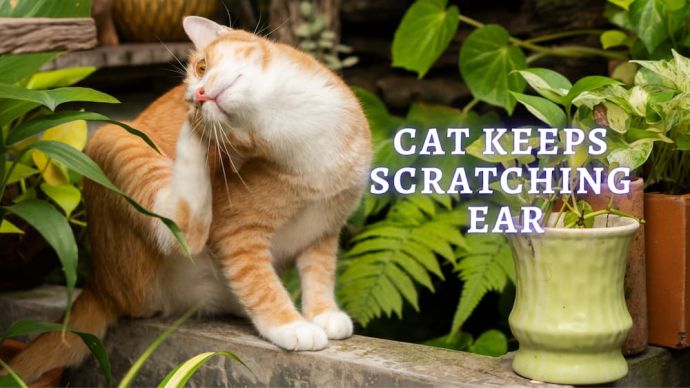 Cat Veterinary Tips Why is my Cat Scratching their Ears? (Veterinary Advice)
Cat Veterinary Tips Why is my Cat Scratching their Ears? (Veterinary Advice) - 1253
- 0
 Cat Care Cat Drinking a Lot of Water: Health and Behavior Reasons Why Your Cat Drinks So Much
Cat Care Cat Drinking a Lot of Water: Health and Behavior Reasons Why Your Cat Drinks So Much - 425
- 0
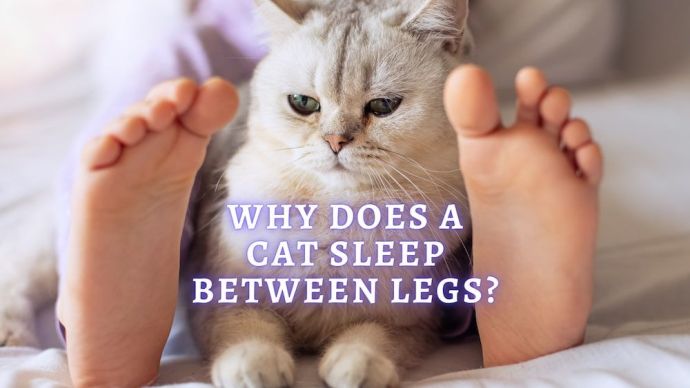 Cat Care Why Does My Cat Sleep Between My Legs? 7 Reasons Why Do Cats Sleep Between Legs
Cat Care Why Does My Cat Sleep Between My Legs? 7 Reasons Why Do Cats Sleep Between Legs - 179
- 0
 Cat Care Why Does My Cat Attack My Legs? 10 Reasons Why and What To Do About It (Vet-Approved Advice)
Cat Care Why Does My Cat Attack My Legs? 10 Reasons Why and What To Do About It (Vet-Approved Advice) - 45566
- 21
 Cat Veterinary Tips Cat Stomach Gurgling: Vet Advice on Why is Your Cat Stomach Gurgling?
Cat Veterinary Tips Cat Stomach Gurgling: Vet Advice on Why is Your Cat Stomach Gurgling? - 35339
- 4
 Cat Veterinary Tips My Cat Lost its Voice: Can Cats get Laryngitis? (Vet Advice)
Cat Veterinary Tips My Cat Lost its Voice: Can Cats get Laryngitis? (Vet Advice) - 23247
- 13









